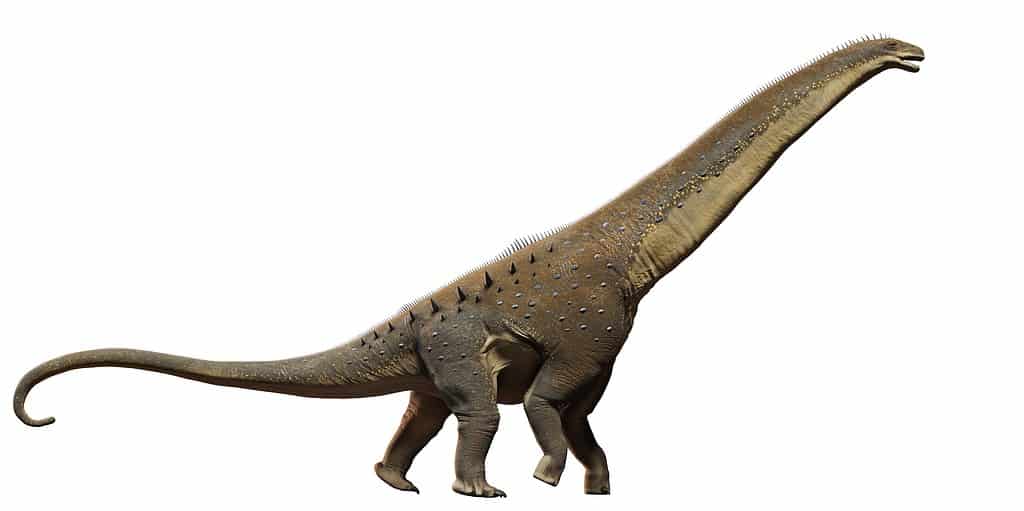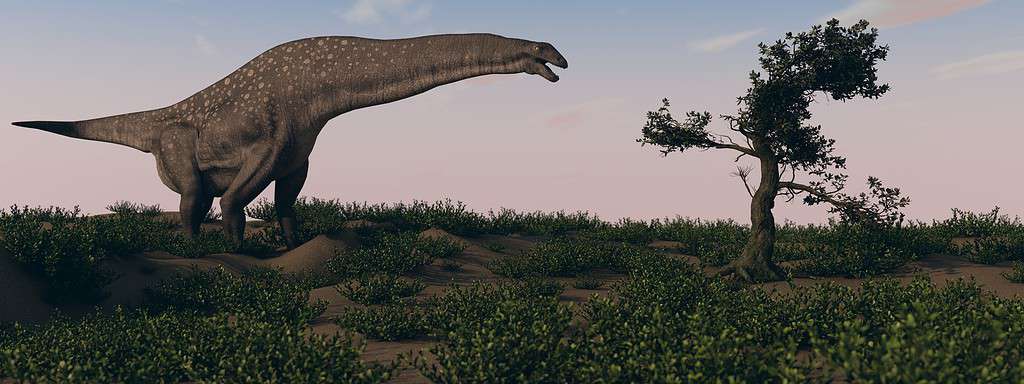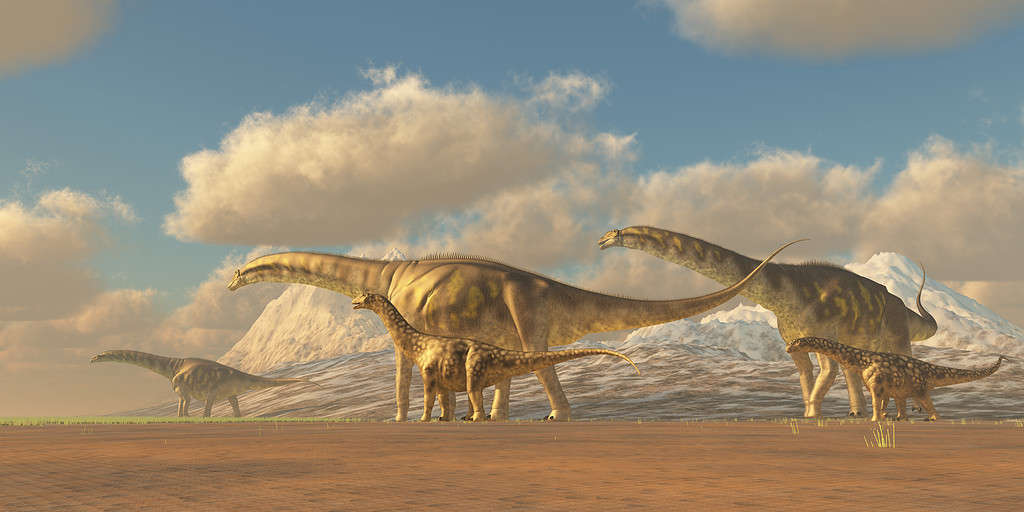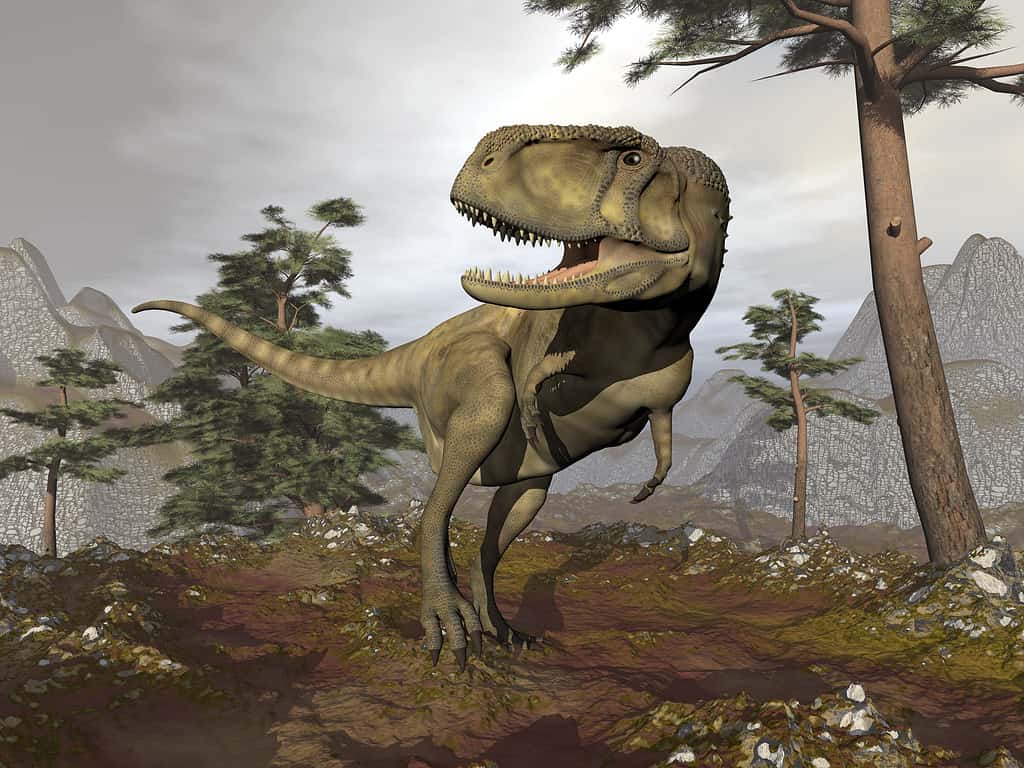Titanosaur
Among the largest land animals to ever exist
Advertisement
Titanosaur Scientific Classification
Read our Complete Guide to Classification of Animals.
Titanosaur Conservation Status
Titanosaur Facts
- Group Behavior
- Group
- Fun Fact
- Among the largest land animals to ever exist
- Biggest Threat
- Large predators
- Most Distinctive Feature
- Nasal crest
- Distinctive Feature
- Large nostrils but small head
- Habitat
- Woodlands and forests
- Predators
- Abelisaurus, Tyrannosaurus Rex
- Diet
- Herbivore
- Lifestyle
- Diurnal
- Favorite Food
- Leaves, twigs, fruit, bark
- Location
- Worldwide
View all of the Titanosaur images!
Titanosauria is a clade of large sauropod dinosaurs that collectively go by the name titanosaurs. You can find titanosaur fossils on all seven continents, including Antarctica, making them one of the most widespread dinosaur groups. Titanosaurs were exclusively herbivorous, and most featured large bodies and long necks. The group includes some of the largest land animals ever, including Patagotitan, Argentinosaurus, and Puertasaurus.
Description and Size
Although titanosaurs were typically quite large, they varied in size depending on the species. For example, Argentinosaurus measured between 98 and 115 feet long and weighed between 66 and 85 short tons. Meanwhile, Magyarosaurus measured just 20 feet long and weighed from 1,650 to 2,200 pounds. Generally speaking, the largest discovered fossils come from South America, while the smallest fossils come from Europe, which was made up mostly of islands during the Cretaceous Period.
The shape of titanosaur heads varies, with some appearing like diplodocids while others appear more like brachiosaurids. Compared to other sauropods, titanosaurs possessed relatively small but wide heads, with large nostrils and characteristic nasal crests. Their teeth almost always measured quite small and appeared either spoon-like or peg-like.
Like other sauropods, titanosaurs had long necks and whip-like tails. While their tails weren’t as whip-like as other sauropods, titanosaurs had much wider chests. They walked with a distinctive wide-legged stance which differentiates their tracks from other sauropods. Additionally, they possessed a solid but flexible spinal column, which made them quite agile, especially compared to other sauropods.
In terms of color, we’ll likely never know what titanosaurs looked like. However, we know that their skin consisted of armored plates made up of small and large interlocking scales.

Titanosaurs had long necks and whip-like tails.
©Dotted Yeti/Shutterstock.com
Evolution and History
Upon its discovery in 1877, Richard Lydekker declared a new taxon for his discovered fossils called Titanosauridae. Over the years, several paleontologists added and removed genera to and from the clade. In 1993, Jose Bonaparte and Rodolfo Coria determined that a new clade comprising all discovered titanosaurs was necessary to reorganize the various fossils based on shared characteristics. They named the clade Titanosauria, which is the group used to classify titanosaurs today. That said, the evolutionary history and taxonomic classification of titanosaurs remain up for debate. Given that titanosaurs share similar features with other sauropods, additional findings may adjust their classification in the future.
Diet – What Did Titanosaurs Eat?
Given their long necks and large size, titanosaurs were most likely browsers that ate leaves, fruit, twigs, and bark from tall trees. However, fossilized dung from the late Cretaceous discovered in India grants additional insight into the diet of titanosaurs. Scientists found a wide range of plant fragments within this dung, including conifers and cycads. Moreover, the dung also contained fragments of grasses and palms. This finding indicates that titanosaurs may have eaten a more varied diet than first anticipated.

Given their long necks and large size, titanosaurs were most likely browsers that ate leaves, fruit, twigs, and bark from tall trees.
©Kostiantyn Ivanyshen/Shutterstock.com
Habitat – When and Where it Lived
Titanosaurs first appeared around 140 million years ago during the Early Cretaceous Period. Specifically, they date back to the boundary of the Berriasian and Valanginian stages of the Early Cretaceous. They lived all the way up to the end of the Late Cretaceous Period, approximately 66 million years ago.
Titanosaurs lived all around the world in various environments. Paleontologists have found titanosaur fossils on every continent, including Antarctica. Fossils have been discovered in Brazil, New Zealand, Argentina, Australia, and the Gobi Desert. While you can find titanosaur fossils worldwide, most discovered fossils come from the Southern Hemisphere. During the Cretaceous Period, the southern continents composed the supercontinent Gondwana. At that time, flowering plants emerged, most likely in western Gondwana. These flowering plants eventually took over much of the landscape, and browsers such as titanosaurs became the dominant herbivores.

Titanosaurs lived all around the world in various environments.
©Catmando/Shutterstock.com
Threats and Predators
Few predators could tangle with a mature titanosaur due to the latter’s large size. Additionally, large sauropods like titanosaurs often lived in large herds or groups. Members of the group lived together for protection, thereby granting them a greater chance of surviving an attack from predators. That said, a few predators that lived during the Cretaceous Period possessed enough strength and ability to threaten small or juvenile titanosaurs. For example, an adult Tyrannosaurus Rex or Abelisaurus could hurt or kill a titanosaur. Both of these apex predators possessed jaws powerful enough to take down small or medium-sized sauropods.
Despite their great size, the greatest threat to titanosaurs probably came from small, unassuming predators. A site in western India revealed an extraordinary find that backs up this claim. The fossils found at the site revealed a baby titanosaur being eaten by a snake. Due to the small size of the eggs, predation by snakes and other small reptiles makes perfect sense. This finding reinforces well-documented examples from modern animal ecosystems, which demonstrate that the youngest and weakest members of the group frequently face the greatest risk of predation.

was an apex predator that would have been powerful enough to have preyed on the titanosaur.
©iStock.com/Elenarts108
Discoveries and Fossils – Where It was Found
British paleontologist Richard Lydekker discovered the first titanosaur fossils in 1877 at a site in India. Based on the discovery of two caudals and a femur from an unknown dinosaur species, Lydekker named the dinosaur Titanosaurus indicus. He chose the name titanosaur in honor of the Titans of Greek mythology. The Titans were the pre-Olympian gods who ruled the cosmos until they were defeated and removed by the children of the Titan Kronos, the Olympians.
From the late 19th to the early 21st century, titanosaur fossils have been found all over the world. For example, paleontologists first discovered Argentinosaurus in 1987 at a farm near Plaza Huincul, Argentina. Similarly, Patagotitan was discovered by a farm laborer in the desert near La Flecha, Argentina. Meanwhile, Dreadnoughtus and Puertasaurus were discovered in the Cerro Fortaleza Formation in Santa Cruz Province, Argentina, in 2005 and 2001, respectively.
Extinction – When Did It Die Out?
Different titanosaurs disappeared at different points during the Cretaceous Period. However, the last titanosaurs died out at the end of the Late Cretaceous Period, around 66 million years ago. Around that time, a massive asteroid crashed into the Yucatan Peninsula in modern-day Mexico. This impact sent immense amounts of debris into the air that caused rapid global cooling and created intense volcanic and tectonic activity. Known as the Cretaceous-Paleogene extinction event, this event marks one of the 5 worst mass extinctions in history, known as the “Big 5.” Over the next several thousand years, nearly three-quarters of all life on earth went extinct.
Similar Animals to Titanosaurs
- Diplodocus. One of the most recognizable dinosaurs in the world, Diplodocus is a genus of large diplodocid sauropod from the Late Jurassic Period. It held the title of the world’s largest dinosaur for many years and was well-known for its long neck, strong legs, and a whiplike tail.
- Supersaurus. Meaning “super lizard,” Supersaurus is a genus of diplodocoid dinosaur from the Late Jurassic Period. First discovered in 1972 in Colorado, it may rank as the largest land animal ever. Length estimates for Supersaurus range from 105 to 138 feet, while hypothetical weights vary between 35 and 40 short tons.
- Brachiosaurus. Brachiosaurus is a genus of sauropod dinosaur from North America. It lived around 154 to 150 million years ago during the Late Jurassic Period. The name translates to “arm lizard,” in reference to its long, proportionate arms. In terms of size, it measured between 59 and 72 feet long and weighed 31.2 to 51.7 short tons.
Titanosaur FAQs (Frequently Asked Questions)
When did Titanosaurs live?
The oldest titanosaur fossils date back 140 million years to the Early Cretaceous Period. Meanwhile, the youngest fossils date back to the end of the Late Cretaceous Period, around 66 million years ago. This means that titanosaurs likely died out during the Cretaceous-Paleogene extinction event.
How big were Titanosaurs?
Titanosaurs ranged widely in size from massive to relatively small. For example, Argentinosaurus may have measured between 98 and 115 feet long and weighed between 66 and 83 short tons. On the other hand, Magyarosaurus measured just 20 feet long and weighed between 1,650 and 2,200 pounds.
Thank you for reading! Have some feedback for us? Contact the AZ Animals editorial team.
Sources
- American Museum of Natural History, Available here: https://www.amnh.org/exhibitions/permanent/orientation-center/the-titanosaur
- Field Museum, Available here: https://www.fieldmuseum.org/exhibitions/maximo-titanosaur
- Natural History Museum, Available here: https://www.nhm.ac.uk/visit/exhibitions/titanosaur.html
- CNN, Available here: https://www.cnn.com/2021/01/19/americas/dinosaur-largest-titanosaur-intl-scli-scn/index.html

















